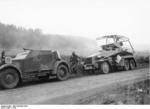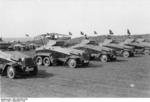SdKfz 231/232/263 (6-Rad)
| Country | Germany |
| Primary Role | Armored Car |
Contributor: Alan Chanter
ww2dbaseThe origins of the SdKfz. 231 (6 Rad) Schwere Panzespähwagen ("heavy armored reconnaissance vehicle") armoured car began in the late 1920s when the German Army began to consider their requirement for a large armoured car that could be employed on internal security and border control duties. At that time the most effective way of obtaining a reasonable cross-country performance without excessive cost was to use a six-wheeled lorry with drive transmission to all four rear wheels. Design work began in 1930, taking the Daimler G3 6 x 4 commercial vehicle chassis as a starting point with development being undertaken in secret at the Kazan test centre in the Soviet Union. The first design to be accepted for service was that produced by Daimler-Benz AG of Berlin Marienfeld, thirty-seven vehicles being delivered in 1932 and in the following year a model from the Bussing-NAG Vereinigte Nutzkraftwerk AG of Brunswick also appeared. These were followed in 1934 with a similar model built by C.D.Magirus AG (Klockner-Humboldt-Deutz) of Ulm Donau.
ww2dbaseAll three models were basically similar in layout (having been built to the same specification), with only minor variations such as the bonnet length and form of radiator protection. Structurally, they were all based on their makers’ commercial truck chassis, suitable strengthened. The armoured hulls in the first vehicles, of the three manufacturers, initially differed but eventually a standardised form was developed. The engine was at the front, and the transmission (which included a forward-reverse selector which allowed the cars to be driven in reverse at top speed from an alternative rear-hulled steering position that incorporated driver’s controls as well as a steering wheel) to the rear axles. All the rear wheels were dual and all wheels had bullet-proof tyres. Suspension was by means of longitudinal leaf springs.
ww2dbaseThe well angled armoured hulls were supplied by Deutsche Edelstahl of Hanover and Deutsche Werke of Kiel and were ballistically much in advance of those of most contempories of the era. The hull was surmounted by a hand-operated turret with all-round traverse and mounted a 20mm KwK 38 cannon and (usually) a coaxial 7.92mm machine gun. A crew of four was carried.
ww2dbaseAn interesting feature of the SdKfz. 231 was the provision of ground rollers. One disadvantage of the six-wheeled chassis had been that the relatively long wheelbase was liable to ground when going over rough country. To counter this tendency a roller was suspended beneath the nose of the vehicle to prevent it embedding on steep slopes or on the far banks of ditches and, on the Magirus models (which were the last in production), a roller was added midway between the front wheels and the leading pair of rear wheels to prevent the hull from grounding.
ww2dbaseProduction ran from 1932-35, by which time around 1,000 had been built. They were always regarded as an interim design and in 1936 manufacture ceased in favour of the preferred rear-engine eight-wheeled car. Nevertheless sufficient numbers had been constructed to re-equip the Wehrmacht and these performed invaluable service, during the 1930s, with the Army for training and exercises.
ww2dbaseThe main flaw with the SdKfz. 231 (6 Rad) was that the armoured hull (it had a 14.5mm base) was too heavy for the chassis and this coupled with the lack of drive to the front wheels resulted in a poor cross-country performance. However, they were used on roads to good effect during the occupation of Czechoslovakia and large numbers were employed by the German Panzer Division’s Reconnaissance Battalions (Aufklärungs Abteilung) in the Blitzkrieg campaigns in Poland and France during 1939 and 1940 (their appearance alone often having a good propaganda value). Thereafter they were withdrawn from front-line service as the newer eight-wheeled heavy armoured cars became available, and largely relegated to internal security duties in occupied countries.
ww2dbaseThe six-wheeled armoured cars were built in two other versions: The SdKfz. 232 (6-Rad) (Fu) Funkwagen was a long-range radio vehicle similar to the SdKfz. 231 for the battalion’s staff signal section. It was recognizable by its prominent tubular "bedstead" frame aerial on top of the vehicle. This aerial was attached to two fixed brackets at the rear if the hull, but incorporated a rotating central pivot from which arms descended to the turret, which thus retained all-round traverse. This equipment made the SdKfz. 232 slightly heavier than the armoured car (6.15 tons as opposed to 5.9 tons). The other version was the 5.75-ton SdKfz. 263 Panzerfunkwagen (6-Rad), a command vehicle with a fixed non-rotating turret armed with only a single 7.92mm machine gun. This vehicle carried a crew of five men instead of four.
ww2dbaseSources:
Philip Trewhitt, Armoured Fighting Vehicles (Dempsey-Parr, 1999)
Ian V Hogg and John Weeks, The Illustrated Encyclopedia of Military Vehicles (Hamlyn Publishing, 1980)
B. T. White, Tanks and other AFVs of the Blitzkrieg Era 1939-41 (Blandford Press, 1972)
Bryan Perrett, German Armoured Cars and Reconnaissance Half-Tracks 1939-45 (Osprey New Vanguard, 1999)
Last Major Revision: Jun 2012
SPECIFICATIONS
SdKfz. 231 (6-Rad)
| Machinery | One Daimler-Benz 3,460cc 6-cyl petrol engine rated at 68bhp, one Bussing-NAG 4-cyl petrol engine rated at 65hp, or one Magirus 6-cyl water cooled petrol engine rated at 70hp |
| Suspension | Wheels |
| Armament | 1x20mm KwK 38 cannon, 1x7.92mm coaxial machine gun |
| Armor | 8-15mm |
| Crew | 4 |
| Length | 5.57 m |
| Width | 1.82 m |
| Height | 2.25 m |
| Weight | 5,700.0 t |
| Speed | 65 km/h |
| Range | 250 km |
Photographs
 |  |  |
Você gostou deste artigo ou achou este artigo útil? Se sim, considere nos apoiar no Patreon. Qualquer valor já vai ajudar! Obrigado. Por favor, ajude-nos a divulgar o site: Fique atualizado com WW2DB: |
Visitor Submitted Comments
All visitor submitted comments are opinions of those making the submissions and do not reflect views of WW2DB.

- » Wreck of Teruzuki Found (27 jul 2025)
- » USS Orlean's Bow Found (22 jul 2025)
- » The Emperor of Japan Planned to Honor WW2-era Japanese POWs in Mongolia (4 jul 2025)
- » US State Lawmaker John Winter Caught Using Racial Slur "Jap" and Apologized (11 jun 2025)
- » US Government Plans to Purge WW2 Information (17 mar 2025)
- » Ver todas as notícias
 |
- » 1,181 biografias
- » 337 eventos
- » 45,132 entradas na linha do tempo
- » 1,249 navios
- » 350 modelos de aeronaves
- » 207 modelos de veículos
- » 376 modelos de armas
- » 123 documentos históricos
- » 261 instalações
- » 470 resenhas de livros
- » 28,426 fotos
- » 365 mapas
General Douglas MacArthur at Leyte, 17 Oct 1944
Por favor, considere nos apoiar no Patreon. Mesmo R$1 por mês já faz uma grande diferença. Obrigado!
Ou, por favor, nos apoie adquirindo alguns produtos do WW2DB na TeeSpring. Obrigado!
21 Oct 2009 05:37:15 PM
The Sd.Kfz. 231 were built by Bussing-NAG the
first models were delivered in 1937.
The vehicle had good cross-country capabitity
however, the vehicle was complex with all- wheel drive and steering. Production ended in
1942 with 1,235 delivered.